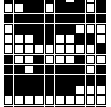
 |
The breath of Arrhenius: air conditioning in photographic archives |
Tim Padfield and Jesper Stub Johnsen
This is the full text of the article which is published in the book: Research Techniques in Photographic Conservation
The article is divided into two chapters to speed loading.
Observations on collections of photographs show that the rate of deterioration is very variable, depending as much on the quality of the processing as on the inherent stability of the materials. The current standard storage climate for negatives is based on the degradation rate of cellulose acetate. This climate does not prevent the deterioration of badly manufactured or processed film but demands expensive equipment that is not necessary for the survival of sheet film that is in good condition. We suggest an approach to collections management which eases the climate specification for the bulk of the collection, compensated by regular surveying of the collection with eye, nose and chemical sensors. Decaying images are found and put into a cold store to retard deterioration, followed by copying and possible chemical treatment.
We describe the types of deterioration commonly observed in collections of black and white sheet films. This survey suggests that the standard recommended for the storage climate is both too lax, in that it does not prevent deterioration of unstable images, and too strict, in that it imposes the technical and cost burden of full air conditioning, wherever in the world the archive is situated. We explore an alternative strategy for collection management which combines an active policy of inspection and treatment with climate control based on the minimum modification of the local climate that will give a safe microclimate in the store.
Figure 1 shows a typical result from a condition survey of a collection of photographs. This collection spans from about 1900 to the mid 1950's. The negatives are on glass, nitrate and acetate base. The collection has always been housed in a palace in Copenhagen, never air conditioned, drifting during the year between 16C at 25% relative humidity (RH) and 28C and 60% RH.
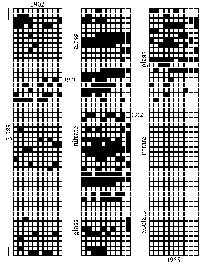
Figure 1 A tabular representation of a survey of a collection of photographs. Each square represents an individual negative. White squares represent silver gelatine images in good condition while black squares represent discolored or bleached images.Click here to enlarge picture
A striking feature of the survey is that all the deterioration is in the image rather than the base. The negatives marked as in bad condition suffer from discoloured or bleached silver gelatine emulsions. The film base appears to have no influence on this deterioration and is itself in good condition.
A common feature of such surveys is the presence of groups of bad pictures. Figure 2a shows two boxes full of wrapped negatives, each box with a clearly defined centre of decomposition, evidently caused by reactive vapours, because the wrappers are disintegrating.
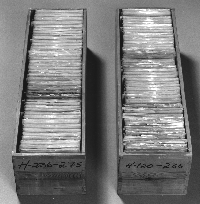
Figure 2 a: An example of damage spreading from a point source of corrosive vapour. The two boxes each contain around 1500 nitrate negatives. The dark spots are caused by deteriorating film base.
Figure 2b shows a series of negatives adjacent to a 'diseased' negative, showing rapidly diminishing damage with increasing separation.
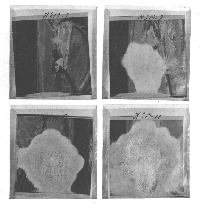
b: Negatives from the discoloured area in the right box. The base deterioration has apparently started in the negative shown at bottom right, attacking the negative in close contact (bottom left), while deterioration in the negative at top left has only just started.
In figure 3 we show in schematic form how one would expect the state of a collection to develop in the next few decades. The condition now is represented by row A.
If the collection is steadily and uniformly deteriorating one would expect a pattern like row B, where the oldest images are the worst.
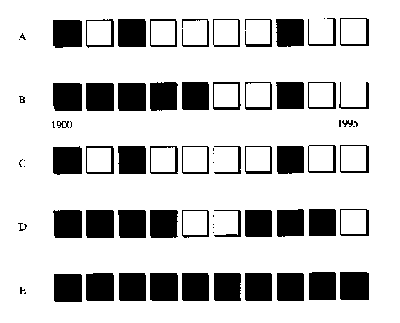
Figure 3 A schematic representation of the state of preservation of negatives in a collection. The present state is represented by row A. Row B shows the likely result of a survey in 30 years time if negatives primarily deteriorate with age. C predicts the future condition if the deterioration is due to bad processing. D shows the effect of negatives attacking neighbours through emission of acid vapours. Finally, if a bad environment is the main cause of deterioration the result will look like row E.
If bad processing has caused some photographs to decay one would not expect a different pattern of deterioration over the next decades, because the bad photos have already selected themselves out. A prediction for the future state of such a collection is illustrated in row C.
If one decomposing picture is attacking its neighbours through emission of acid vapours, the prediction for the future state can be seen in row D.
If the storage environment is the main cause of deterioration, all images can be expected to show signs of deterioration in the future, as illustrated in row E.
It seems that the collection described in figure 1 has not suffered from a bad environment and that the observed deterioration can be attributed to inherent vice in a few of the negatives.
From this analysis we define the care of a collection of photographs as a combination of four activities:
1. Regular inspections to identify deteriorating images.
2. Identification of the reason for this decay.
3. Removal of these negatives for copying, preservative chemical treatment (1) or stabilisation through cold storage (2).
4. Maintenance of a moderate climate around the stable bulk of the collection.
This last component of our scheme: ensuring a moderate climate for the pictures that are in good condition, is the main subject of this article.

This work is licensed under a Creative Commons Attribution-Noncommercial-No Derivative Works 3.0 License.